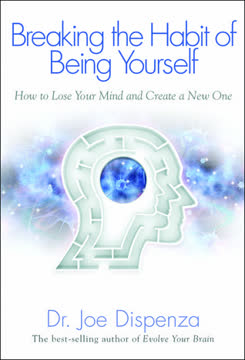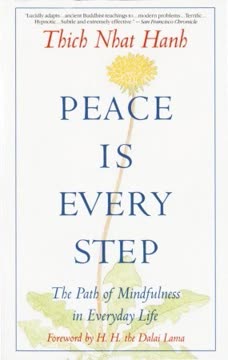Key Takeaways
1. Embrace Life's Opposites: Balance and Equanimity as Keys to Peace
Creation, destruction. Joy, suffering. Pleasure, pain. But know that you are something beyond that.
Life is a play of opposites. Success and failure, gain and loss, happiness and pain - these dualities are inherent in our existence. The key to inner peace lies in maintaining equanimity amidst these fluctuations. Instead of being swayed by extreme emotions, strive to remain centered and balanced.
Challenges are opportunities for growth. When faced with difficulties, view them as stepping stones for personal development rather than obstacles. A tough boss, for instance, can help you develop valuable skills and resilience. By shifting your perspective, you can transform challenges into catalysts for improvement.
Acceptance is crucial. Recognize that opposites coexist in nature and in our lives. By accepting this fundamental truth, you can reduce stress and find greater harmony. Remember that you are beyond these dualities - your essence remains unchanged amidst life's ever-changing circumstances.
2. Transform Negative Emotions Through Awareness and Acceptance
Negativity needs an anchor.
Awareness is the first step. Recognize that negative emotions often arise from our own thoughts and perceptions. By becoming aware of these patterns, we can begin to change them. Pay attention to how your body feels when experiencing different emotions - this physical awareness can help dissipate negativity.
Practice acceptance, not resistance. When negative emotions arise, don't fight them. Instead, acknowledge their presence without judgment. This acceptance paradoxically allows the emotions to pass more quickly. Remember that all emotions are temporary - they will come and go like waves in the ocean.
Use spiritual practices to transcend negativity. Techniques such as meditation, breathwork, and self-reflection can help you rise above negative thought patterns. These practices cultivate a witness consciousness, allowing you to observe your emotions without being controlled by them. Regular practice can lead to a more positive and balanced emotional state.
3. Cultivate Love and Compassion in Relationships
True love is always one-sided. True love is not expecting anything in return from the other person.
Love without expectation. Genuine love is unconditional and doesn't demand reciprocation. When you love without expecting anything in return, you free yourself from disappointment and resentment. This pure form of love is liberating and nurturing for both the giver and the receiver.
Practice compassion and understanding. When someone behaves negatively, try to see beyond their actions to the pain or fear that might be driving them. This perspective shift can transform your reactions from judgment to empathy. Remember that everyone is fighting their own battles, often unseen to others.
Cultivate a sense of oneness. Recognize that at our core, we are all interconnected. This realization naturally fosters love and compassion. As you develop this awareness, you'll find it easier to forgive, accept, and genuinely care for others, even in challenging situations.
4. Live in the Present Moment: The Art of Mindfulness
Life is not just the time between some events, the time between birth and death. Life is beyond that.
Embrace the now. The present moment is all we truly have. By fully engaging with what's happening right now, we can reduce anxiety about the future and regrets about the past. Practice mindfulness in daily activities - whether eating, walking, or talking - to cultivate a deeper sense of presence.
Let go of past and future. Our minds often dwell on past events or worry about future possibilities, robbing us of the richness of the present. Recognize when your thoughts drift to past or future, and gently bring your attention back to the current moment. This practice can lead to greater peace and fulfillment.
Expand your perception of time. Understand that life is more than just the events between birth and death. It's an eternal continuum, vast and boundless. This perspective can help you transcend the limitations of linear time and connect with a deeper, more expansive sense of existence.
5. Service and Generosity: Pathways to Fulfillment and Joy
The way to overcome personal misery is to share universal misery! The way to expand personal joy is to share universal joy.
Shift from "me" to "we". True fulfillment comes from expanding beyond self-centered concerns to caring for others. By serving others and contributing to the greater good, we naturally alleviate our own suffering and expand our capacity for joy.
Practice generosity. Generosity is a quality of the spirit that brings abundance into your life. It's not about material wealth, but about an attitude of giving and sharing. Even in difficult circumstances, you can cultivate generosity through kind words, compassionate actions, or simply offering your presence to others.
Find purpose in service. Make service your primary commitment in life. This shift in focus can dissolve ego-centered worries and bring a sense of purpose and fulfillment. Remember that service isn't just about grand gestures - small acts of kindness in daily life can have profound impacts.
6. Meditation: The Journey from Movement to Stillness
Meditation is the journey from movement to stillness, from sound to silence.
Understand the essence of meditation. At its core, meditation is about moving from the external world of activity to the internal world of stillness. It's a natural process of returning to your original state of being - peaceful, joyful, and unbounded.
Practice regularly. Consistency is key in meditation. Set aside time each day for your practice, even if it's just a few minutes. As you progress, you'll find that meditation brings deep rest, clarity, and a sense of expanded awareness.
Key aspects of meditation:
- Let go of expectations and desires
- Observe thoughts without judgment
- Cultivate a sense of witnessing consciousness
- Allow yourself to settle into the silence between thoughts
Integrate meditation with daily life. The benefits of meditation extend beyond the practice itself. As you cultivate inner stillness, you'll find that you can maintain a sense of calm and centeredness even in the midst of daily activities.
7. Spiritual Growth: From Self to Universal Consciousness
Enlightenment is unveiling one's own nature rather than achieving something through effort or skill.
Understand the nature of enlightenment. Enlightenment is not about gaining something new, but about uncovering your true nature. It's a process of peeling away layers of conditioning and false identifications to reveal the pure consciousness that you already are.
Expand your identity. Move beyond limited identifications based on gender, race, nationality, or personal history. Recognize your essential nature as pure consciousness, interconnected with all of existence. This expanded sense of self naturally leads to greater compassion, wisdom, and inner peace.
Stages of spiritual growth:
- From being somebody to being nobody
- From being nobody to being everybody
Cultivate awareness and dispassion. Develop the ability to witness your thoughts, emotions, and experiences without getting caught up in them. This witnessing consciousness, combined with a sense of dispassion or non-attachment, allows you to navigate life's challenges with greater ease and grace.
8. The Role of a Spiritual Teacher in Personal Transformation
Your spiritual teacher is the door.
Understand the purpose of a spiritual teacher. A genuine spiritual teacher serves as a doorway to higher consciousness, offering guidance, inspiration, and practical tools for inner transformation. They provide a living example of the teachings and can help you navigate the challenges of the spiritual path.
Cultivate a deeper connection. The relationship with a spiritual teacher goes beyond physical proximity or personal interactions. It's about aligning with their consciousness and seeing the world through their perspective. This alignment can accelerate your spiritual growth and help you transcend limitations.
Signs of a genuine spiritual teacher:
- Knowledge flourishes in their presence
- Sorrow diminishes
- Joy arises spontaneously
- Abundance manifests
- Talents and creativity blossom
Balance devotion and discernment. While trust and devotion are important in the teacher-student relationship, maintain your discernment. A true teacher encourages questioning and personal experience rather than blind faith. They empower you to discover your own innate wisdom and potential.
Last updated:
FAQ
1. What is "Notes for the Journey Within: Essentials of the Art of Living" by Ravi Shankar about?
- Practical Spiritual Wisdom: The book is a collection of short, practical teachings and insights from Gurudev Sri Sri Ravi Shankar, focusing on how to live a balanced, joyful, and meaningful life.
- Art of Living Philosophy: It introduces the core principles of the Art of Living Foundation, blending ancient Indian wisdom with modern-day challenges.
- Personal Growth and Well-being: The content covers topics like managing stress, relationships, desires, meditation, and service, aiming to help readers find inner peace and fulfillment.
- Accessible Format: The book is organized into concise notes and knowledge sheets, making it easy to read in sequence or by topic, suitable for both newcomers and those familiar with spiritual teachings.
2. Why should I read "Notes for the Journey Within" by Ravi Shankar?
- Universal Relevance: The book addresses common human experiences—stress, happiness, relationships, and purpose—making it relevant to anyone seeking personal growth.
- Actionable Insights: Each note offers practical advice and mind/body techniques that can be immediately applied to daily life.
- Spiritual and Secular Balance: It bridges the gap between spiritual wisdom and everyday living, without requiring adherence to any particular religion or dogma.
- Inspiration and Upliftment: Readers often find the teachings uplifting, helping them cultivate resilience, compassion, and a deeper sense of belonging.
3. What are the key takeaways from "Notes for the Journey Within" by Ravi Shankar?
- Embrace Life’s Opposites: Life is a play of opposites—joy and sorrow, gain and loss—and wisdom lies in maintaining equanimity amidst them.
- Present Moment Awareness: True happiness and clarity come from living in the present, letting go of past regrets and future anxieties.
- Letting Go and Dispassion: Dispassion is not apathy but the ability to let go, which is essential for inner peace and centeredness.
- Service and Connection: Serving others and feeling a sense of belonging are central to personal fulfillment and spiritual growth.
4. How does "Notes for the Journey Within" define the "Art of Living" and its basic principles?
- Balance and Equanimity: The Art of Living is about balancing life’s ups and downs, accepting both with a smile.
- Mind’s Nature: The mind tends to hold onto negativity; awareness and meditation help purify and center the mind.
- Acceptance and Letting Go: Accepting people and situations as they are, and letting go of expectations, are key to reducing stress and increasing joy.
- Action Without Anxiety: Acting with full attention, without being anxious about results, leads to fulfillment and effectiveness.
5. What is SKY Breath Meditation, and how is it featured in "Notes for the Journey Within"?
- Signature Technique: SKY Breath Meditation is a unique breathing practice taught by the Art of Living Foundation, developed by Sri Sri Ravi Shankar.
- Health and Wellness Benefits: The book highlights SKY as a tool for reducing stress, anxiety, and depression, and for enhancing mental clarity and well-being.
- Integration with Teachings: Meditation, including SKY, is presented as a practical way to embody the book’s principles, helping to let go of negativity and cultivate inner peace.
- Scientific Backing: The method is supported by research from institutions like Yale and Stanford, as mentioned in the author’s biography.
6. How does "Notes for the Journey Within" by Ravi Shankar address handling stress, challenges, and negative emotions?
- Shift Perspective: Challenges are seen as opportunities for growth and “polishing” oneself, rather than as obstacles.
- Embrace, Don’t Resist: The book advises embracing disturbances and emotions rather than resisting them, as observation leads to their dissolution.
- Practical Steps: Techniques like meditation, self-inquiry, and service are recommended to manage stress and transform negative emotions.
- Acceptance and Generosity: Acceptance, feeling blessed, and cultivating generosity are emphasized as antidotes to misery and stagnation.
7. What guidance does "Notes for the Journey Within" offer on relationships and love?
- Love Beyond Emotion: Love is described as the very nature of existence, not just an emotion or transaction.
- Respect and Intimacy: True respect for others reflects one’s own greatness, and maintaining intimacy requires letting go of ego and expectations.
- Handling Conflict: The book provides advice on dealing with blame, jealousy, and mistakes with compassion and understanding.
- Unconditional Love: It encourages assuming others love you, avoiding demands, and practicing forgiveness and gratitude to sustain relationships.
8. What is the book’s approach to desires, happiness, and the nature of joy?
- Desire as Delusion: Desires promise future happiness but often lead to more desires; true joy is found in the present moment.
- Three Types of Happiness: The book distinguishes between fleeting pleasure, happiness that leads to suffering, and lasting joy from self-discipline and spiritual growth.
- Letting Go of “Always”: The pursuit of “always” being happy or comfortable is seen as a source of frustration; dropping this expectation brings contentment.
- Intention and Manifestation: Attention and intention shape experience, but clinging to intentions creates tension; letting go allows true joy to arise.
9. How does "Notes for the Journey Within" explain the mind, ego, and overcoming negative patterns?
- Nature of the Mind: The mind is influenced by place, time, food, past experiences, and associations; awareness helps transcend these influences.
- Ego and Self-Image: Ego creates separation and suffering; dropping self-image and identifying with the higher Self brings freedom.
- Impressions and Expression: The mind gets caught in its own web of impressions; meditation and self-inquiry help release these patterns.
- Creativity and Wonder: Breaking the barrier of the rational mind and embracing wonder are encouraged for creativity and spiritual growth.
10. What is the role of meditation and spiritual practice in "Notes for the Journey Within"?
- Journey to Stillness: Meditation is described as the journey from movement to stillness, and from sound to silence, returning to one’s true nature.
- Three Golden Principles: Effective meditation involves wanting nothing, doing nothing, and being nothing, allowing the mind to settle into its source.
- Stages and Benefits: Meditation brings relaxation, energy, creativity, enthusiasm, and ultimately a sense of oneness with the universe.
- Practical Advice: The book offers tips for overcoming restlessness, dropping intentions, and integrating meditation into daily life for deep rest and bliss.
11. How does "Notes for the Journey Within" by Ravi Shankar define enlightenment, the spiritual path, and the Higher Self?
- Enlightenment as Simplicity: Enlightenment is being unconditionally happy, moving from being “somebody” to “nobody” to “everybody.”
- Letting Go and Witnessing: The path involves letting go of self-blame, witnessing the mind, and recognizing the impermanence of all things.
- Faith and Dispassion: Faith in oneself, the world, and the Divine, along with dispassion, are seen as essential qualities for spiritual growth.
- Oneness and Service: Realizing oneness with all, serving others, and seeing the Divine in everyone are hallmarks of the enlightened state.
12. What are the best quotes from "Notes for the Journey Within" by Ravi Shankar, and what do they mean?
- “Life is a play of opposites. The art is to embrace the opposites, accommodate the paradoxes, and live with a smile.”
This highlights the importance of accepting life’s dualities and maintaining inner balance. - “Expectations are just imaginations of the future. If you expect something, inevitably you’ll be disappointed or the joy you’ll get out of it will be reduced.”
Letting go of expectations increases joy and reduces suffering. - “Dispassion is NOT apathy! Dispassion is full of activity and enthusiasm, yet devoid of feverishness.”
True dispassion means being active and engaged without attachment or anxiety. - “Enlightenment is like a joke! It’s like a fish searching for the ocean.”
Enlightenment is our natural state, already present within us; we only need to recognize it. - “Service brings merit. Merit allows you to go deeper in meditation. Meditation brings back your smile.”
This quote encapsulates the book’s emphasis on the interconnectedness of service, spiritual practice, and inner joy.
Review Summary
"Notes for the Journey Within" receives overwhelmingly positive reviews, with readers praising its profound yet accessible wisdom. Many find it transformative, offering practical guidance for daily life challenges and spiritual growth. Readers appreciate the book's format, allowing for both linear reading and random selection of relevant passages. The author's simple language and relatable examples resonate with many, who describe the book as a constant companion, providing clarity, solace, and inspiration. Some readers gift copies to loved ones, considering it an essential guide for navigating life's complexities.
Similar Books








Download PDF
Download EPUB
.epub digital book format is ideal for reading ebooks on phones, tablets, and e-readers.






